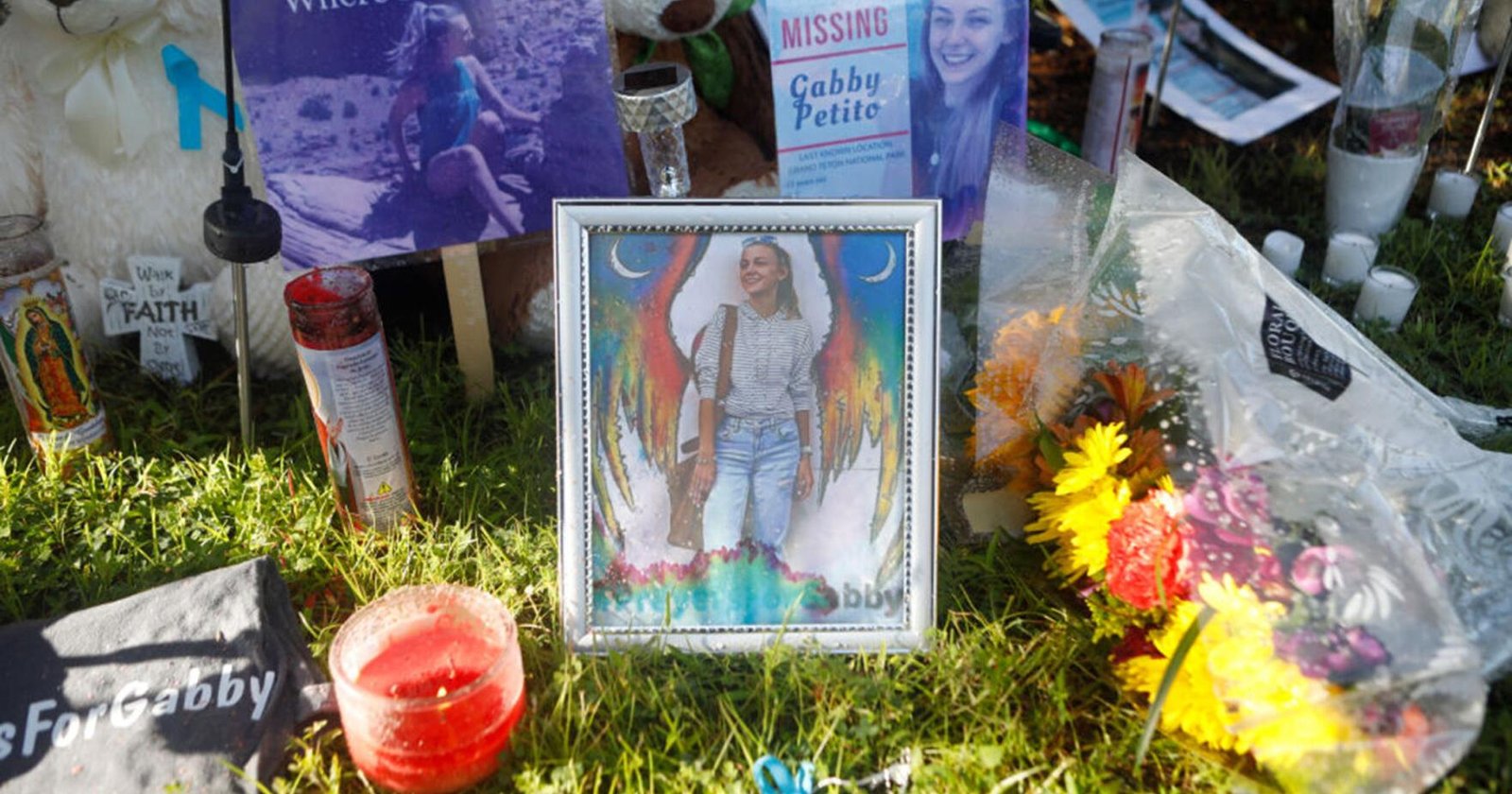Down the true-crime rabbit hole | Lifestyle | nny360.com – NNY360
Sunny to partly cloudy. High 13F. Winds WNW at 5 to 10 mph..
Mostly cloudy. A few flurries or snow showers possible. Low 2F. Winds SW at 5 to 10 mph.
Updated: February 14, 2022 @ 7:57 am
A makeshift memorial dedicated to Gabby Petito is located near City Hall on Sept. 20 in North Port, Fla. Petito went missing while on a cross-country trip with her boyfriend, Brian Laundrie. Octavio Jones/Getty Images/TNS
The Zodiac Killer stabbed or shot to death five people in Northern California in 1968 and 1969. He was dubbed the Zodiac Killer after he sent taunting letters and cryptograms to police and newspapers that included astrological symbols. Sacramento Bee photo illustration/TNS
A makeshift memorial dedicated to Gabby Petito is located near City Hall on Sept. 20 in North Port, Fla. Petito went missing while on a cross-country trip with her boyfriend, Brian Laundrie. Octavio Jones/Getty Images/TNS
The Zodiac Killer stabbed or shot to death five people in Northern California in 1968 and 1969. He was dubbed the Zodiac Killer after he sent taunting letters and cryptograms to police and newspapers that included astrological symbols. Sacramento Bee photo illustration/TNS
SAN JOSE, Calif. — One day in 2007, I found myself in the basement of the Contra Costa County Superior Courthouse in Martinez, staring at a partial bloody footprint on the lid of a plastic bin. The footprint looked markedly similar to the tread on the bottom of the teenage boy’s slip-on shoe I held in my hand.
I had fallen down a true-crime rabbit hole. Somehow I had hoped that seeing the shoe and footprint in person would help me make sense of a gruesome murder I’d covered as a reporter. A teenager who had gone to my high school had been convicted of bludgeoning his 52-year-old female neighbor to death.
Even after the boy’s conviction, I scoured public records, hit up key players for insights and traded theories on mid-2000s message boards. And, yes, my curiosity led me into a courthouse basement to search through boxes of crime scene evidence.
Fifteen years later, I don’t have more clarity on this case, but I know I’m not alone in going down a rabbit hole in a high-profile crime, even when the results are elusive.
In her 2018 New York Times bestseller, “I’ll Be Gone in the Dark,” the late author Michelle McNamara wrote about her obsession with uncovering the identity of the Golden State Killer, before the arrest of Joseph DeAngelo. And retired cops and amateurs have spent decades trying to name the Zodiac, the terrorizing figure linked to five Bay Area murders in the late 1960s.
More casual consumers of true crime feed a genre that sprawls across TV networks, streaming services, podcasts, movies, Facebook and Reddit groups and the annual CrimeCon convention. Fans of murder and missing-person narratives consistently push crime documentaries to No. 1 spots on Netflix. And last fall, so-called web sleuths feverishly tracked the ill-fated road trip of Gabby Petito and Brian Laundrie, making the 22-year-old woman’s disappearance a national sensation.
Why are we so obsessed?
Criminologists discount the idea that the public fascination with tales of violence and mayhem is necessarily morbid, unhealthy or exploitative. Our interest, they say, is very, well, human. If murder has long been a popular subject for entertainment, that’s because humans are innately intrigued by mysteries, puzzles and whodunits.
Certainly, the enduring interest in the Zodiac Killer is largely due to the puzzles he left behind — menacing letters he sent to the media, in which he claimed responsibility and shared cryptograms he said would reveal his identity.
For Virginia software developer David Oranchak, it was an intellectual challenge to successfully decipher a 340-character cryptogram the Zodiac sent the San Francisco Chronicle in 1969. “I hope you are having fun trying to catch me,” the cipher began, as Oranchak and two colleagues discovered.
Oranchak and his fellow cryptographers spent 14 years trying to crack the Zodiac’s code, finally succeeding in December 2020, as the FBI acknowledged.
“There is sometimes great satisfaction in solving hard problems,” Oranchak said via email.
But beyond the satisfaction of playing detective, people are hard-wired for empathy. It’s in our nature to want to understand why people do terrible things, especially people who could be our neighbors, classmates or co-workers, said David Schmid, an associate professor of English at the University of Buffalo who studies crime narratives and popular culture. And telling stories has always been a way for humans to create order out of chaotic events.
“I think the more confusing and complicated and frustrating the world around us is, the stronger that desire is to have something make sense. I think that’s a big part of the fascination with mystery and cold cases,” Schmid, a Stanford alum, said.
Schadenfreude “is always going to be part of the equation,” he said, with people feeling relieved that “thank god, it’s them and not me.”
Crime stories appeal to our “visceral instincts” and fears for our safety, said Scott Bonn, a criminologist and author of “Why We Love Serial Killers: The Curious Appeal of the World’s Most Savage Murderers.” Like Greek tragedies, horror movies and roller coaster rides, these stories allow us to experience terror in a controlled way — the adrenaline rush followed by catharsis.
Bonn noted that producers at Discovery, Oxygen and the A&E network arrange their true-crime shows accordingly. The shows allow people to live in the “nightmare” of a crime but end with a resolution — police finding a body or arresting the criminal. “They are like little morality plays,” he said, “and in the end, justice prevails.”
Indeed, a concern for justice is part of the attraction of true-crime cases for people avidly following a case in the media or for an investigative writer such as McNamara, who wanted the victims of the Golden State Killer to find relief with his arrest. “The hook for me was that the case seemed solvable,” McNamara wrote.
Sadly, McNamara died in 2016, two years before authorities identified the Golden State Killer as DeAngelo, an ex-police officer living in Citrus Heights. Paul Holes, the former Contra Costa County criminalist who helped find the DNA link between a relative of DeAngelo’s and one of the crime scenes, credited McNamara with uncovering details that weren’t in the original case files.
Holes’ work on the Golden State Killer case also made him a star in true-crime circles, and he has continued to work on cold cases in retirement. He co-hosts a popular true-crime podcast, “The Murder Squad,” which spotlights long-forgotten cases.
When questions about a case linger, public interest grows. It’s that need for “a story” for why a crime happened, said Jennifer Buckholtz, a Los Gatos-reared criminal justice professor at the American Military Institute, who investigates cold cases as a volunteer and has helped with recent efforts to name the Zodiac Killer.
Buckholtz is gratified that she helped provide that “story” for people following the long-unsolved 2004 murder of 22-year-old Rebekah Gould, an Arkansas college student. Buckholtz’s work helped police identify a suspect, news that also provided answers for Gould’s family.
“(Rebekah’s dad) told me countless times, I just want the guy involved, ‘I want the story,’” Buckholtz said.
Experts chart Americans’ fascination with true-crime back to the sensationalist media coverage on both sides of the Atlantic of Jack the Ripper, who murdered and mutilated women in London in the late 1800s. Throughout the 20th century, the American public devoured lurid, dime-store crime novels, gangster movies, high-minded nonfiction like Truman Capote’s “In Cold Blood” and the circuslike coverage of cases from the kidnapping of the Lindbergh baby to the trial of O.J. Simpson.
Schmid believes the fascination with true crime went “mainstream” in the late 1980s or ‘90s. “Before, someone’s fascination might be their dirty secret,” he said. But he noticed the shift during the 1992 Academy Awards when “The Silence of the Lambs,” the thriller about FBI profiling of serial killers, won best picture. At one point, host Billy Crystal came onstage in Hannibal Lecter’s famous mask.
“How is it possible that Hannibal Lecter and Anthony Hopkins were the stars of the evening?” said Schmid.
Thirty years later, Hannibal Lecter’s stature as an icon of American pop culture has only grown, but Schmid argues that our enduring fascination with the world of crime can serve another important human need: to create “a more just and equal society.”
Thoughtfully crafted narratives can bring attention to policing, the court system, human behavior and social policy, he said. More recently, the genre has made room for magazine articles, documentaries and podcasts about wrongful convictions and police abuses.
“This form of popular culture has so much potential to be exploitative and problematic,” Schmid said, “yet I also think it has the potential to do good.”
Tribune Wire
Your comment has been submitted.
Reported
There was a problem reporting this.
Log In
Keep it Clean. Please avoid obscene, vulgar, lewd, racist or sexually-oriented language.
PLEASE TURN OFF YOUR CAPS LOCK.
Don't Threaten. Threats of harming another person will not be tolerated.
Be Truthful. Don't knowingly lie about anyone or anything.
Be Nice. No racism, sexism or any sort of -ism that is degrading to another person.
Be Proactive. Use the 'Report' link on each comment to let us know of abusive posts.
Share with Us. We'd love to hear eyewitness accounts, the history behind an article.




